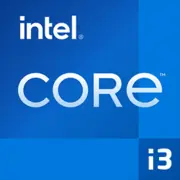Intel Core i3-1305U

Intel Core i3-1305U: Compact Power for Everyday Tasks
March 2025
Modern laptops require a balance between performance, energy efficiency, and price. In this review, we will examine the Intel Core i3-1305U processor — a budget solution for ultrabooks and work laptops. We will find out who it is suitable for, how it performs in real scenarios, and what to pay attention to when buying.
Architecture and Technology: Hybrid Cores and Optimization
Hybrid Raptor Lake Architecture
The Core i3-1305U belongs to the 13th generation of Intel (codename Raptor Lake) and is produced on Intel 7 technology (equivalent to 10 nm). Its distinguishing feature is its hybrid core structure:
- 1 performance core (P-core) with Hyper-Threading support (2 threads).
- 4 energy-efficient cores (E-core) without Hyper-Threading.
In total: 5 cores and 6 threads. Base frequency is 1.2 GHz, with a maximum turbo frequency of 4.5 GHz for the P-core and 3.3 GHz for the E-cores.
Intel UHD Graphics for the 13th Generation
The integrated GPU is Intel UHD Graphics (for the 13th generation) with 64 EU (Execution Units) and a frequency of up to 1.25 GHz. It supports 4K@60 Hz via HDMI 2.1, AV1 decoding, and HDR. For gaming, it is only suitable at low settings: for example, CS:GO at 720p provides 40-50 FPS.
Power Consumption and TDP: Balancing Power and Battery Life
The nominal TDP of the processor is 15 W, which is typical for ultrabooks. However, in turbo mode, power can temporarily reach 55 W, requiring an efficient cooling system.
Energy-saving technologies:
- Intel Dynamic Tuning 2.0 — automatically adjusts frequencies based on workload.
- Adaptix Thermal Framework — optimizes fan operation to reduce noise.
In laptops with passive cooling (for example, Acer Swift 3), the processor may limit frequencies during prolonged workloads, but this is not critical for office tasks.
Performance: From Office to Casual Gaming
Real-World Task Tests
- Office Work (Chrome, Excel, Zoom): 10-15 tabs + video call — no lags.
- Multimedia: 4K video in VLC or YouTube — smooth playback. Photo editing in Lightroom — acceptable for basic retouching, but exporting 100 images will take around 7 minutes.
- Gaming: Fortnite at 720p/low — 35-40 FPS; Indie games (Hollow Knight, Stardew Valley) — 60 FPS.
Turbo Mode: Brief Boost
In Turbo Boost mode (up to 4.5 GHz), the processor speeds up application launches and handles short-term tasks. For example, opening Photoshop will take 2-3 seconds. However, after 15-20 seconds, the frequency drops to 3.8 GHz due to heating.
Use Cases: Who is the i3-1305U Suitable For?
1. Students and Office Workers — for document work, online courses, Zoom meetings.
2. Home Laptop Users — surfing the web, streaming, light photo editing.
3. Mobile Users — thanks to the low TDP, such laptops are lightweight (from 1.2 kg) and thin.
Not Suitable For:
- Gamers (except for casual gaming).
- Video editors (4K rendering will be slow).
Battery Life: Up to 10 Hours in Energy-Saving Mode
Laptops with the i3-1305U and a 50-60 Wh battery provide:
- 8-10 hours with text work and web browsing (brightness at 50%).
- 5-6 hours during streaming video (Netflix, YouTube).
Energy Savings:
- Intel Speed Shift — instant switching between C-state modes.
- Windows 12 Optimization — AI mode "EcoBalance" reduces background load.
Tip: Turn off Turbo Boost in power settings to extend battery life by 15-20%.
Comparison with Competitors
AMD Ryzen 3 7440U
- Pros: 6 Zen 4 cores, better in multi-threaded tasks (Geekbench Multi ~4200).
- Cons: Higher price for laptops (from $700).
Apple M1 (2023)
- Pros: Better battery life (up to 14 hours), fast SSD.
- Cons: Limited compatibility with Windows programs.
Intel Core i5-1245U (Previous Generation)
- Pros: Cheaper (laptops from $450).
- Cons: 20% weaker in single-threaded tests.
Pros and Cons of the Core i3-1305U
Strengths:
- Energy efficiency.
- Sufficient performance for everyday tasks.
- Support for modern standards (Wi-Fi 6E, Thunderbolt 4).
Weaknesses:
- Limited multi-threaded power.
- Weak iGPU for gaming.
Laptop Selection Recommendations
1. Device Type: Ultrabooks (Asus ZenBook, Lenovo Yoga) or budget models (HP Pavilion, Acer Aspire 5).
2. Minimum Configuration:
- 8 GB RAM (16 GB preferred for multitasking).
- 512 GB NVMe SSD.
- IPS screen with a resolution of 1920x1080.
3. Prices: $550–$800 depending on brand and specifications.
Examples of 2025 Models:
- Lenovo IdeaPad Slim 5i ($599): 16 GB RAM, 1 TB SSD, 15.6" FHD.
- Dell Inspiron 14 ($699): touchscreen, Thunderbolt 4.
Final Conclusion
The Intel Core i3-1305U is a good choice for those looking for an affordable, lightweight laptop with long battery life. It will handle office tasks, web browsing, and light creativity but is not designed for professional workloads. If your budget is up to $800 and you need a reliable companion for studying or working, this processor is worth considering. However, for gaming or video editing, it's better to look at models with Ryzen 5 or Core i5.
Basic
CPU Specifications
Memory Specifications
GPU Specifications
Miscellaneous
Benchmarks
Compared to Other CPU
Share in social media
Or Link To Us
<a href="https://cputronic.com/cpu/intel-core-i3-1305u" target="_blank">Intel Core i3-1305U</a>